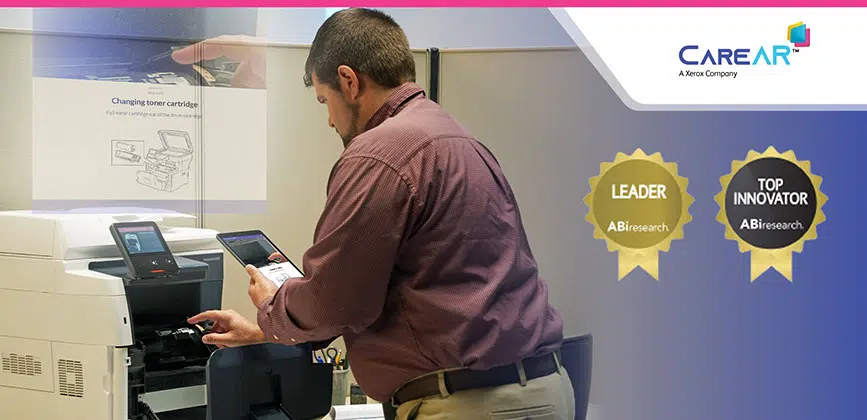ABI Research has recognized CareAR™ in “Companies to know” from its 2022 Recognizing Market Leaders compilation. In the Enterprise Augmented Reality Platforms segment, CareAR was named a “Leader” and “Top Innovator.”
This recognition is notable in the fast-moving augmented reality (AR) space. ABI Research included CareAR in its most recent Enterprise Augmented Reality Platforms competitive ranking due in part to a platform approach that encompasses immersive self-solve, as well as AR remote assistance. CareAR technology innovation is fueling new use cases with process transformation not easily achieved without next generation leaps in technology.
For example, ABI research noted that CareAR “machine vision scores are quite good” and “object and state detection is supported as well for step verification.” What this means for users is an enhanced user experience with graphical annotated guidance that is contextually accurate and sticks in place even when a user moves their smartphone, tablet of wearable glasses. It also empowers new forms of augmented reality step-by-step guidance that can dynamically adjust based on accurate computer vision capture that does not rely on training an AI model with photos or video.
Now is the time to examine how the augmented reality power that is literally in everyone’s pocket can benefit your organization. Some 28 percent of the U.S. population uses AR monthly, according to Insider Intelligence and eMarketer. Statista forecasts that more than 23 million jobs worldwide will be enhanced by VR and AR technologies by 2030. And an IDC report forecasts a $4.1 billion investment into AR/VR/mixed reality (MR) for training.
As ABI Research’s report notes: “With 2022 already in full swing, there are still ample opportunities to set yourself apart from your competitors in your market.” CareAR Service Experience Management (SXM) helps provide immersive customer and employee experiences that are remembered and shared, along with remarkable cost saving opportunities realized by boosting self-solve, avoiding technician dispatches, and enhancing first time fix rates.
So, how can you leverage AR technology? For contact centers, it means engaging your customers using their smartphone rear-facing camera for see-what-I-see awareness coupled with visual guidance. It’s not only more effective, but also can reduce handle times in large part by replacing words with images in product support scenarios.
Self-solve opportunities are expanding, as well. Use cases for field technicians and customers that apply AR for step-by-step guidance supplemented with animations and other content, which users can tailor for their optimal learning style, create new ways to deflect calls and enhance employee performance.
For more information, discover more about what CareAR solutions can do for your service experiences. You can also download the ABI Research 37 Technology Companies Leading the Way in 2022 from ABI Research or just view CareAR’s profile here.
